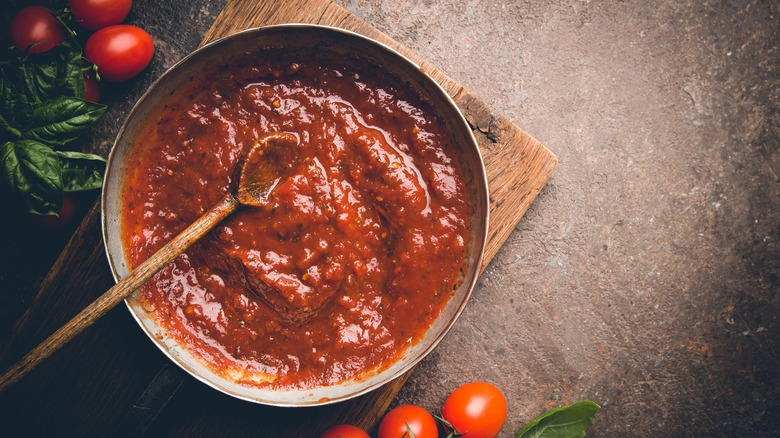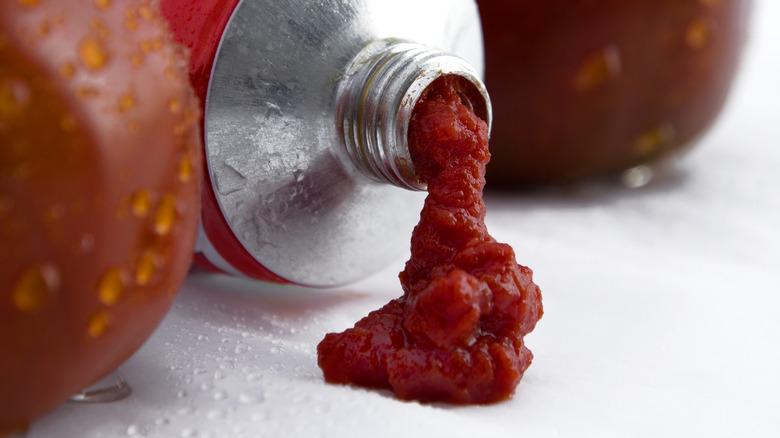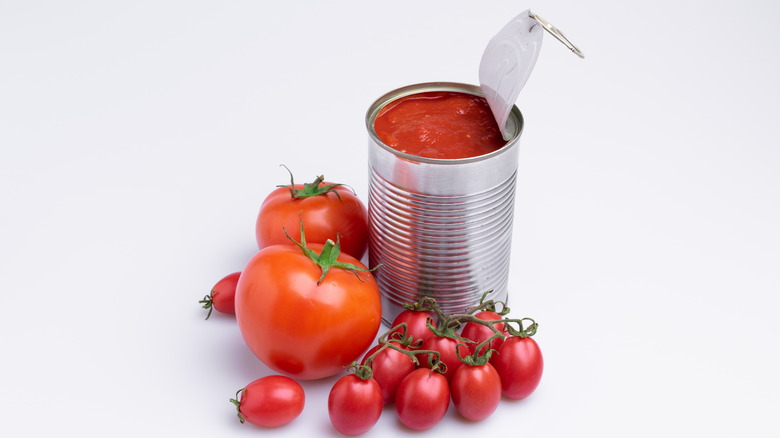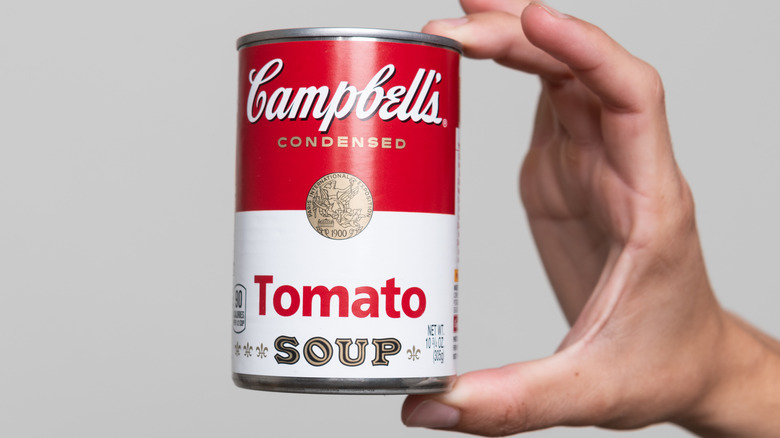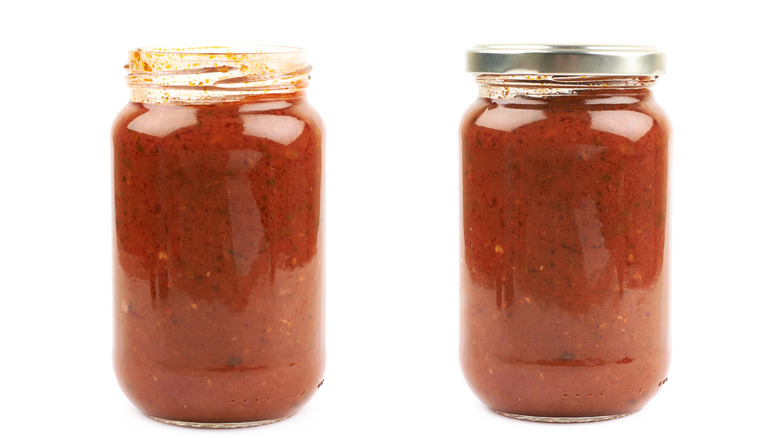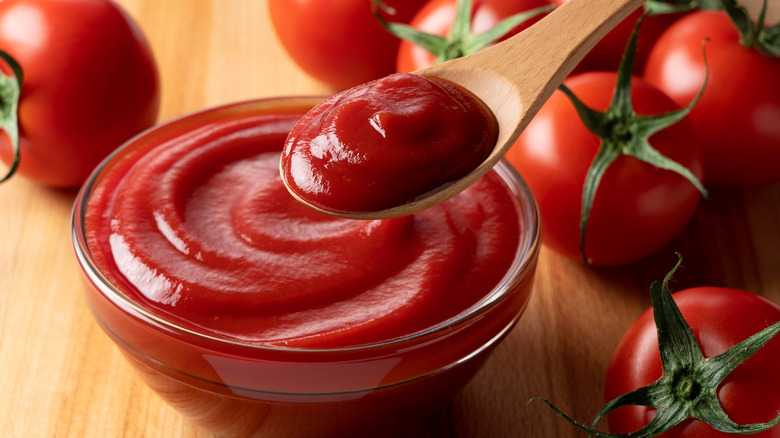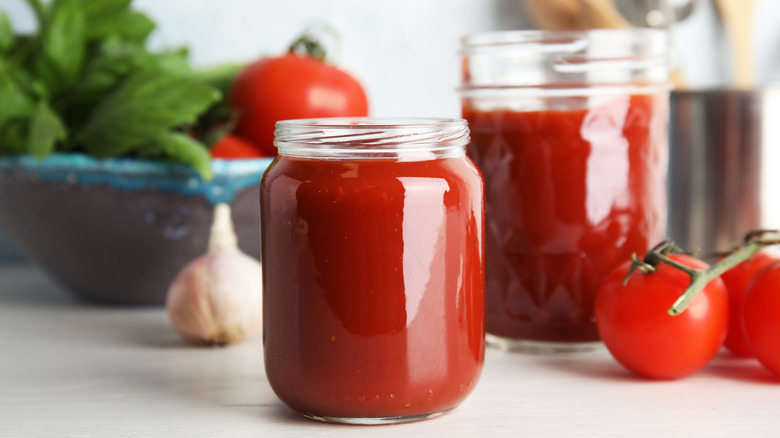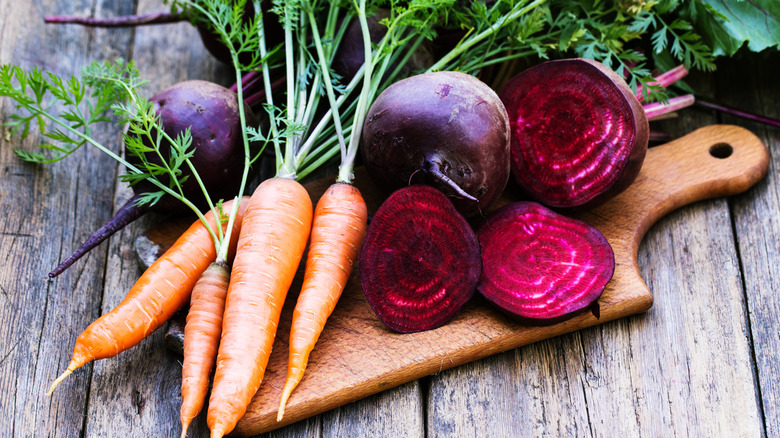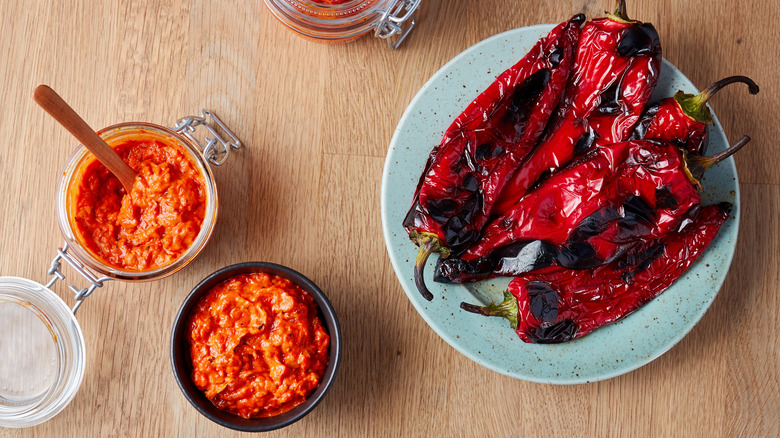10 Best Substitutes For Tomato Sauce
Few things are more frustrating than deciding on a recipe, getting fired-up about making it, and then discovering you don't have a key ingredient. Tomato sauce is one of those vital ingredients, and it's a major component of countless dishes (via Serious Eats). But sometimes you run out, or perhaps you're allergic to tomatoes and need a substitution. The good news is, there are excellent alternatives that might already be behind your pantry doors.
Tomato sauce is a thick, rich blend of vine-ripened tomatoes, salt, spices, and natural flavors, per Hunts. Taste of Home explains that some tomato sauce varieties also contain salt pork or bacon, onions, carrots, bay leaves, garlic, and a flour-butter roux. The blend is simmered for hours, until thickened, which allows flavors to deepen and sweeten slightly.
Known as the third mother sauce, The Chopping Block explains that tomato sauce should balance sweetness with acidity and provide a subtle earthy, umami quality. Tomato sauce is wildly versatile and is used as a core ingredient in sauces, braises, soups, stews, and pizzas. As explained by Tasting Table, since canned tomato sauce has been partially cooked, it's mildly acidic; when added early on in a recipe, it mellows and sweetens over time, and when added just before serving, it adds a "jolt" to a finished dish.
To mimic the sweetness, acidity, and umami quality of tomato sauce, check out these swaps.
1. Tomato paste
The Spruce Eats asserts that if you have a can or tube of tomato paste in your stockpile, you've got the perfect replacement for tomato sauce. The site recommends mixing together one part tomato paste with one part water and blending it until smooth. That means if you need one cup of tomato sauce in your marinara, mix together 1/2 cup tomato paste and 1/2 cup water. For a flavor similar to canned tomato sauce, add herbs, garlic, and onion. For a more traditional, authentic tomato sauce (like grandma would make), sauté fresh onion and garlic in olive oil until soft before adding them to the tomato paste/water blend. Lastly, taste as you go and, if necessary, add a bit of olive oil or a pinch of sugar.
RecipeTin Eats shares a "mock" tomato sauce recipe that replaces one 14-ounce can of tomato sauce with 4 tablespoons of tomato paste mixed with 1 1/2 cups water, 1 1/2 tablespoons all-purpose flour, and 1 1/2 teaspoons sugar. The mixture will be watery at first but thickens as it cooks.
2. Canned tomatoes
Although canned tomatoes may seem like an obvious choice for replacing canned tomato sauce, there's actually a bit of a difference. My Frugal Home explains that crushed tomatoes can be puréed until smooth and used to replace tomato sauce, just be aware that the sauce will be thicker than regular tomato sauce. You can also blend canned diced or stewed tomatoes, and those options will produce a thinner sauce. If the sauce is too thin for your needs, it can be "cooked down" or simmered until it reaches the right consistency. Note that when using stewed tomatoes, many varieties also contain onion, bell peppers, celery, salt, sugar, and a bunch of Italian herbs so make sure to take that into consideration when crafting your dish.
The Spruce Eats suggests draining and reserving the liquid from canned tomatoes before puréeing them into tomato sauce — that way you can adjust the thickness of the sauce as it cooks (by adding the reserved liquid).
Substitute equal parts canned tomatoes for tomato sauce.
3. Tomato soup
Not just the ideal partner for a stretchy grilled cheese, tomato soup makes a great substitute for tomato sauce. Taste Essence claims that because canned tomato soup is condensed, one can (10 3/4 ounces) can replace one cup of tomato sauce plus 1/4 cup of water.
EHow notes that although both tomato sauce and tomato soup start out with tomatoes, they each have their own nuances. Tomato sauce consists of tomatoes that have been cooked down and thickened and seasoned with garlic and herbs. Some tomato sauce varieties (especially commercially made brands) contain additional ingredients, such as red wine, sausage, onions, cheese, hot red peppers, and/or mild green bell peppers. Canned tomato soup also consists of tomatoes, but the puréed fruit is typically seasoned simply with salt, and pepper and immersed in a broth or milk base. In some cases, tomato soup is scented with aromatics like celery, carrots, and bay leaves. Read the label on your tomato soup to make sure the flavor profile works with your dish.
As noted above, 10 3/4 ounces of condensed tomato soup can replace one cup of tomato sauce plus 1/4 cup of water or other liquid in your dish.
4. Marinara sauce
Since few pantries are complete without at least one jar of marinara sauce, consider using the tomato-based staple in place of tomato sauce when you're in a pinch. Simple at Home claims that marinara sauce is a fine substitute for tomato sauce in many recipes, especially pizza, chili, and other savory dishes. Note that since marinara sauce is often designed as a one-stop-shop for flavor (and intended to be served directly over pasta), there may be added herbs and spices that will alter the taste of your dish.
Lidia's Italy explains that marinara sauce is often quickly made and seasoned simply with garlic, crushed red pepper, and basil. The sauce can be chunky or smooth, and the taste is that of "fresh tomatoes." On the other hand, tomato sauce often consists of tomatoes, onion, carrot, celery, and bay leaf, and is simmered much longer, until thick and rich. Thanks to the sweet aromatics and lengthy cooking time, tomato sauce is "sweeter and more complex."
That said, you may substitute an equal amount of marinara sauce for tomato sauce, but the swap may change the consistency and flavor of your meal.
5. Tomato juice
Shirk the bloody mary and grab tomato juice as your tomato sauce replacement. Substitute Cooking declares that tomato juice can be used in all recipes calling for tomato sauce. But take note — tomato juice is often made from freshly squeezed or crushed tomatoes and contains no preservatives or additives — meaning it has a shorter shelf-life than other tomato sauce alternatives.
Since tomato juice is thinner than tomato sauce, Thrifty Fun suggests simmering the juice down until you reach a consistency more akin to tomato sauce. You can also use a roux (a mixture of flour and fat) to thicken the juice, and Our Everyday Life recommends using two tablespoons of roux for every one cup of tomato juice. For example, heat two tablespoons of butter or oil in a pan until it's hot. Whisk in two tablespoons of flour and cook until the flour begins to turn golden and forms a paste. Whisk in one cup tomato juice and simmer until you reach the consistency of tomato sauce.
When doing the swap, one cup of tomato juice can be used to replace 1/2 cup of tomato sauce and 1/2 cup of water or other liquid in the recipe.
6. Ketchup
This might seem like an odd one, but ketchup is made from tomatoes, so it can certainly work. Fine Cooking explains that ketchup is a "thick, tangy condiment made primarily from tomato concentrate; it gets its tang from vinegar, its sweetness from sugar or corn syrup, and its characteristic flavor from salt and spices, like onion powder." As Survival Freedom points out, two of those ingredients — sugar and vinegar — aren't typically found in tomato sauce, so ketchup is a great substitute as long as it's not the main ingredient.
The University of Nebraska-Lincoln agrees and states that one cup of ketchup can replace one cup of tomato sauce, 1/2 cup sugar, and 2 tablespoons of vinegar. If your recipe doesn't contain sugar or vinegar (such as pasta sauce and pizza sauce), use ketchup sparingly. That said, the sweet/tart combination of ketchup, plus its ability to caramelize as it cooks, makes it a great option for recipes like meatloaf and beef stroganoff (via Quora).
When using ketchup to replace a small amount of tomato sauce, the ratio is one to one.
7. Tomato passata
Tomato passata is basically puréed tomatoes with the seeds and skins removed, and the purée can be chunky or smooth depending on the brand (via The Kitchn). La Cucina Italiana explains that the Italian pantry staple is made by slow cooking "ripe, juicy, aromatic tomatoes ... in large pots to intensify their texture and fragrance." The site explains that the purée is stored in jars and cherished for its prized fresh tomato flavor all year long. We're not suggesting you make passata from scratch; it's widely available in grocery stores nationwide.
PureWow notes that passata is more like tomato purée than tomato paste, so when substituting it for tomato sauce, the ratio is one to one. The site explains that if you want a more concentrated tomato flavor, you can reduce passata by simmering it in a pan until it's about one-third of its original volume. Once the passata is as thick as tomato paste, it may be substituted one to one for the paste. That means, if you follow the suggestions above for tomato paste and you need one cup of tomato sauce, you will need 1/2 cup of the reduced/thickened tomato passata and 1/2 cup of water.
8. Beets and carrots
If you need a non-tomato-based substitute for tomato sauce, a commingling of beets and carrots will do the trick. If you have a tomato allergy or sensitivity to nightshades, Savory Nature shares a recipe that boasts onions, carrots, beets, and garlic. The vegetables are first sautéed in olive oil, then braised in water with a little balsamic and white vinegars. The resulting paste is equal parts sweet and tangy — just like a proper tomato paste — and can be used as such. That means combining one part of the beet/carrot purée with one part water will yield the equivalent amount of tomato sauce.
Detoxinista shares a similar recipe, but the vegetables are sautéed in coconut oil and the braising liquid is enlivened with fresh lemon juice instead of vinegar. Cotter Crunch's version of non-tomato paste also contains onions, carrots, beets, and garlic, but is elevated with vegetable broth (instead of water), pumpkin purée, Italian seasoning, oregano, and parsley.
Combine one part of your tomato-free purée with one part water to substitute for tomato sauce.
9. Ajvar
According to Delishably, store-bought ajvar (a red bell pepper and eggplant spread) is an excellent substitute for folks looking for a tomato-free tomato sauce that actually mimics the real deal. The site explains that, despite the fact that there's not a tomato for miles, it's quite similar to tomato sauce in taste and texture and can be used as a substitute for the sauce in pizza, lasagna, pasta, stuffed peppers, stuffed eggplant, and veal/chicken parmesan.
Kitchen at the Store agrees and suggests using store-bought ajvar and thinning it as desired, until you reach the consistency of tomato sauce.
If you want to make ajvar from scratch, ajvar.com explains that the traditional Balkan recipe features four ingredients: red bell peppers, sunflower oil, salt, and vinegar. Chasing the Donkey shares an easy homemade ajvar recipe that consists of roasted eggplant and bell peppers, olive oil, garlic, and white vinegar. The resulting tomato-paste-like purée is rich and thick and can be thinned with water, one to one, to suit your needs.
If you need one cup of tomato sauce, combine 1/2 cup of ajvar with 1/2 cup water or broth.
10. Puréed bell peppers
If your pantry is devoid of tomatoes but robust with bell peppers, you've got everything you need to make a tomato sauce substitute. Simply Conny shares a recipe for a baked bell pepper purée that's made with one ingredient — bell peppers. The peppers are roasted until charred and softened, puréed until smooth, and jarred until ready to use. This purée can be substituted for tomato sauce one to one and is especially great in pasta recipes.
If roasting peppers is too time-consuming for your weeknight meal prep, The Richmond Times-Dispatch shares a roasted red pepper sauce that utilizes jarred roasted red peppers. Once the peppers are puréed until smooth, the sauce is enriched with onion, garlic, butter, and parsley. You can use this sauce to replace tomato sauce one to one, and it works in a variety of recipes calling for tomato sauce (not just pasta dishes).
Pinch of Yum also has a roasted red pepper sauce that employs jarred peppers, and their versatile sauce is enriched with almonds, garlic, olive oil, and lemon.
This hearty sauce may be substituted for tomato sauce one to one.
